| Listing 1 - 10 of 28 | << page >> |
Sort by
|
Book
ISBN: 9783937816791 Year: 2011 Publisher: Hamburg Hamburg University Press
Abstract | Keywords | Export | Availability | Bookmark
 Loading...
Loading...Choose an application
- Reference Manager
- EndNote
- RefWorks (Direct export to RefWorks)
Despite the current need for reliable and valid test instruments to monitor the sign language acquisition of Deaf children in different countries, very few tests offering strong evidence for their psychometric properties are commercially available. A German Sign Language (DGS) test that focuses on linguistic structures acquired in preschool- and school-aged children (4-8 years old) is urgently needed. The present study uses as a template a test which has sound psychometric properties and has been standardized on another sign language as a starting point for tests of sign languages that are less documented, such as DGS.This book makes a novel contribution to the field by examining linguistic, cultural, methodological, and theoretical issues in the process of the adaptation from the source language test to the target language test, and by providing a model for future test adaptations. It also includes concrete steps for the test development and adaptation process.Adaptation and Evaluation of a German Sign Language Test addresses students and researchers alike who are involved in sign language test development and adaptation. It also provides a comprehensive summary in German.
#KVHA:Taalkunde; Gebarentaal --- #KVHA:Taalonderwijs; Gebarentaal --- #KVHA:Evaluatie; Gebarentaal --- Language
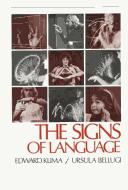
ISBN: 0674807952 0674807960 9780674807952 9780674807969 Year: 1980 Publisher: Cambridge (Mass.): Harvard university press,
Abstract | Keywords | Export | Availability | Bookmark
 Loading...
Loading...Choose an application
- Reference Manager
- EndNote
- RefWorks (Direct export to RefWorks)
Sign language --- Manual Communication --- Manual communication --- #KVHA:Taalkunde gebarentaal --- #KVHA:Amerikaanse gebarentaal --- Sign language. --- Manual communication. --- Manual Communication. --- Langage par signes --- #SBIB:309H53 --- #KVHA:Taalkunde; gebarentaal --- Deaf --- Gesture language --- Language and languages --- Gesture --- Signs and symbols --- Niet-verbale communicatie --- Semiotics
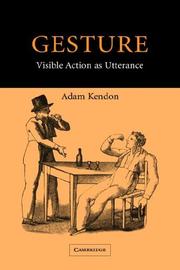
ISBN: 9780521835251 9780521542937 0521835259 0521542936 9780511807572 1316262324 1316260771 0511807570 Year: 2004 Publisher: Cambridge Cambridge University Press
Abstract | Keywords | Export | Availability | Bookmark
 Loading...
Loading...Choose an application
- Reference Manager
- EndNote
- RefWorks (Direct export to RefWorks)
Gesture, or visible bodily action that is seen as intimately involved in the activity of speaking, has long fascinated scholars and laymen alike. Written by a leading authority on the subject, this 2004 study provides a comprehensive treatment of gesture and its use in interaction, drawing on the analysis of everyday conversations to demonstrate its varied role in the construction of utterances. Adam Kendon accompanies his analyses with an extended discussion of the history of the study of gesture - a topic not dealt with in any previous publication - as well as exploring the relationship between gesture and sign language, and how the use of gesture varies according to cultural and language differences. Set to become the definitive account of the topic, Gesture will be invaluable to all those interested in human communication. Its publication marks a major development, both in semiotics and in the emerging field of gesture studies.
#KVHA:Taalkunde Gebarentaal --- #KVHA:Niet-verbale communicatie --- Gestes --- Langage gestuel --- Gebaren. --- Gebarentaal. --- #KVHA:Taalkunde; Gebarentaal --- Gesture. --- Linguistics --- Social psychology --- Semiotics --- Taal. --- Gesture --- Mudra --- Acting --- Body language --- Elocution --- Movement (Acting) --- Oratory --- Sign language
Book
ISBN: 9789027258571 9789027258588 9027258570 9027258589 9027268517 9789027268518 Year: 2015 Volume: 117 Publisher: Amsterdam
Abstract | Keywords | Export | Availability | Bookmark
 Loading...
Loading...Choose an application
- Reference Manager
- EndNote
- RefWorks (Direct export to RefWorks)
In Sign Language Interpreting (SLI) there is a great need for a volume devoted to classic and seminal articles and essays dedicated to this specific domain of language interpreting. Students, educators, and practitioners will benefit from having access to a collection of historical and influential articles that contributed to the progress of the global SLI profession. In SLI there is a long history of outstanding research and scholarship, much of which is now out of print, or was published in obscure journals, or featured in publications that are no longer in print. These readings are significant...
Sign language --- Interpreting --- Translation science --- Semiotics --- Interpreters for the deaf --- Training of --- Study and teaching --- #KVHA:Vertaalwetenschap; Gebarentaal --- #KVHA:Tolken; Gebarentaal --- Interpreters for the deaf. --- Training of. --- Study and teaching. --- Gebarentaal --- Tolken voor doven. --- Tolken --- Tolken. --- Opleiding. --- Deaf --- Gesture language --- Language and languages --- Gesture --- Signs and symbols --- Deaf, Interpreters for --- Sign language interpreters --- Translators --- Translating services --- Means of communication --- Interpreters for the deaf - Training of --- Sign language - Study and teaching --- Interpreters for deaf people
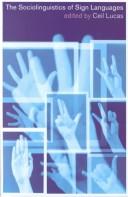
ISBN: 0521794749 0521791375 1107121493 0511174373 0511020260 0511154194 0511303602 0511612826 1280429984 0511046774 9780511020261 9780511154195 9780511046773 9780521791373 9780511612824 9781280429989 9786610429981 6610429987 9780521794749 9781107121492 9780511174377 9780511303609 Year: 2001 Publisher: Cambridge, UK New York Cambridge University Press
Abstract | Keywords | Export | Availability | Bookmark
 Loading...
Loading...Choose an application
- Reference Manager
- EndNote
- RefWorks (Direct export to RefWorks)
This is an accessible introduction to the major areas of sociolinguistics as they relate to sign languages and deaf communities. Clearly organised, it brings together a team of leading experts in sign linguistics to survey the field, and covers a wide range of topics including variation, multilingualism, bilingualism, language attitudes, discourse analysis, language policy and planning. The book examines how sign languages are distributed around the world; what occurs when they come in contact with spoken and written languages; and how signers use them in a variety of situations. Each chapter introduces the key issues in each area of inquiry and provides a comprehensive review of the literature. The book also includes suggestions for further reading and helpful exercises. The Sociolinguistics of Sign Languages will be welcomed by students in deaf studies, linguistics and interpreter training, as well as spoken language researchers, and researchers and teachers of sign language.
Deaf --- Sign language. --- Sociolinguistics. --- Means of communication. --- -Sign language --- Sociolinguistics --- #KVHB:Sociolinguistiek --- #KVHB:Gebarentaal --- Language and languages --- Language and society --- Society and language --- Sociology of language --- Language and culture --- Linguistics --- Sociology --- Integrational linguistics (Oxford school) --- Gesture language --- Gesture --- Signs and symbols --- Deaf-mutes --- Deaf people --- Deafness --- Hearing impaired --- Deafblind people --- Means of communication --- Social aspects --- Sociological aspects --- Sign language --- Patients --- #KVHA:Taalkunde --- #KVHA:Gebarentaal --- #KVHA:Sociolinguïstiek; Gebarentaal --- Speech-reading --- Speechreading --- Communication --- Education --- Speech --- Arts and Humanities --- Language & Linguistics
Book
ISBN: 9780415490672 9780203835654 9781136857935 9781136857973 9781136857980 9780415658157 0415490677 0203835654 0415658152 1136857974 1136857982 1283105020 1780346689 9786613105028 Year: 2011 Publisher: London ;New York Routledge
Abstract | Keywords | Export | Availability | Bookmark
 Loading...
Loading...Choose an application
- Reference Manager
- EndNote
- RefWorks (Direct export to RefWorks)
The flagship title in the Routledge Handbooks in Applied Linguistics series, this volume serves as an introduction and reference point to the key areas in the dynamic evolving field of applied linguistics.
Linguistics --- Sign language --- Interpreting --- gebarentaal --- Sociolinguistics --- Translation science --- Didactics of languages --- tolken --- Applied linguistics --- #KVHA:Toegepaste taalkunde --- Toegepaste taalkunde --- Toegepaste taalkunde.
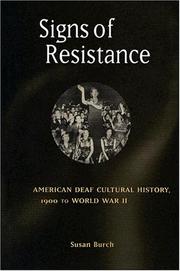
ISBN: 9780814798942 0814798942 0814798918 0814789986 Year: 2002 Publisher: New York : New York University Press,
Abstract | Keywords | Export | Availability | Bookmark
 Loading...
Loading...Choose an application
- Reference Manager
- EndNote
- RefWorks (Direct export to RefWorks)
Choice Outstanding Academic Title 2003 During the nineteenth century, American schools for deaf education regarded sign language as the "natural language" of Deaf people, using it as the principal mode of instruction and communication. These schools inadvertently became the seedbeds of an emerging Deaf community and culture. But beginning in the 1880s, an oralist movement developed that sought to suppress sign language, removing Deaf teachers and requiring deaf people to learn speech and lip reading. Historians have all assumed that in the early decades of the twentieth century oralism triumphed overwhelmingly. Susan Burch shows us that everyone has it wrong; not only did Deaf students continue to use sign language in schools, hearing teachers relied on it as well. In Signs of Resistance, Susan Burch persuasively reinterprets early twentieth century Deaf history: using community sources such as Deaf newspapers, memoirs, films, and oral (sign language) interviews, Burch shows how the Deaf community mobilized to defend sign language and Deaf teachers, in the process facilitating the formation of collective Deaf consciousness, identity and political organization.
#KVHA:American Studies --- #KVHA:Cultuurgeschiedenis; Amerikaanse Gebarentaal --- Deaf --- Deaf-mutes --- Deaf people --- Deafness --- Hearing impaired --- Deafblind people --- History --- Patients --- Orthopedagogiek --- taal- en spraakstoornissen. --- Deaf culture
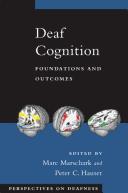
ISBN: 9780195368673 0195368673 Year: 2008 Publisher: New York, NY : Oxford University Press,
Abstract | Keywords | Export | Availability | Bookmark
 Loading...
Loading...Choose an application
- Reference Manager
- EndNote
- RefWorks (Direct export to RefWorks)
#KVHA:Taalkunde; Gebarentaal --- #KVHA:Cultuurgeschiedenis; Gebarentaal --- #KVHA:Dovencultuur --- #KVHA:Dovengemeenschap --- Deaf --- Deaf children --- Hearing impaired children --- Cognitive learning. --- Education. --- Means of communication. --- Cognitive learning --- Gesture language --- Speech-reading --- Speechreading --- Communication --- Education of the deaf --- Learning --- Education --- Means of communication --- Speech --- Cognition --- Surdité --- Sourds --- Enfants sourds. --- Éducation.
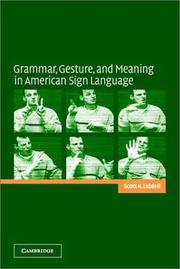
ISBN: 0521816203 0521016509 1107134358 0511178638 0511065167 0511058837 0511305850 0511615051 1280420014 1139148338 0511073623 9780511065163 9780521816205 9780521016506 9780511058837 9780511073625 9781139148337 9780511615054 9781280420016 9786610420018 6610420017 Year: 2003 Publisher: Cambridge New York Cambridge University Press
Abstract | Keywords | Export | Availability | Bookmark
 Loading...
Loading...Choose an application
- Reference Manager
- EndNote
- RefWorks (Direct export to RefWorks)
In sign languages of the deaf some signs can meaningfully point toward things or can be meaningfully placed in the space ahead of the signer. This obligatory part of fluent grammatical signing has no parallel in vocally produced languages. This book focuses on American Sign Language to examine the grammatical and conceptual purposes served by these directional signs. It guides the reader through ASL grammar, the different categories of directional signs, the types of spatial representations signs are directed toward, how such spatial conceptions can be represented in mental space theory, and the conceptual purposes served by these signs. The book demonstrates a remarkable integration of grammar and gesture in the service of constructing meaning. These results also suggest that our concept of 'language' has been much too narrow and that a more comprehensive look at vocally produced languages will reveal the same integration of gestural, gradient, and symbolic elements.
American Sign Language --- Gesture --- Space and time in language --- Grammar --- Semantics --- Gesture. --- Space and time in language. --- Grammar. --- Semantics. --- Arts and Humanities --- Language & Linguistics --- AMESLAN (Sign language) --- ASL (Sign language) --- Sign language --- Language and languages --- Mudra --- Acting --- Body language --- Elocution --- Movement (Acting) --- Oratory --- American Sign Language - Grammar --- American Sign Language - Semantics --- #KVHA:Gebarentaal; Verenigde Staten --- #KVHA:Grammatica; Gebarentaal
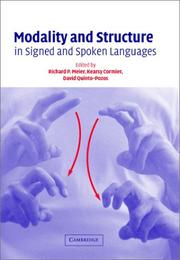
ISBN: 0521803853 0521112583 1107130883 0511178077 0511041616 0511148593 0511330421 0511486774 1280433345 0511043856 9780511041617 9780511486777 9781280433344 9786610433346 6610433348 9780521803854 9780511043857 9780521112581 Year: 2002 Publisher: Cambridge New York Cambridge University Press
Abstract | Keywords | Export | Availability | Bookmark
 Loading...
Loading...Choose an application
- Reference Manager
- EndNote
- RefWorks (Direct export to RefWorks)
The realisation that signed languages are true languages is one of the great discoveries of linguistic research. The work of many sign language researchers has revealed deep similarities between signed and spoken languages in their structure, acquisition and processing, as well as differences, arising from the differing articulatory and perceptual constraints under which signed languages are used and learned. This book provides a cross-linguistic examination of the properties of many signed languages, including detailed case studies of Hong Kong, British, Mexican and German sign languages. The contributions to this volume, by some of the most prominent researchers in the field, focus on a single question: to what extent is linguistic structure influenced by the modality of language? Their answers offer particular insights into the factors that shape the nature of language and contribute to our understanding of why languages are organised as they are.
Gesture --- Modality (Linguistics) --- Sign language --- #KVHA:Taalkunde; Gebarentaal --- #KVHA:Modaliteit --- #KVHA:Structuur --- Deaf --- Gesture language --- Mudra --- Linguistics --- Acting --- Body language --- Elocution --- Movement (Acting) --- Oratory --- Arts and Humanities --- Language & Linguistics --- Typologie (linguistique) --- Universaux (linguistique)
| Listing 1 - 10 of 28 | << page >> |
Sort by
|

 Search
Search Feedback
Feedback About UniCat
About UniCat  Help
Help News
News